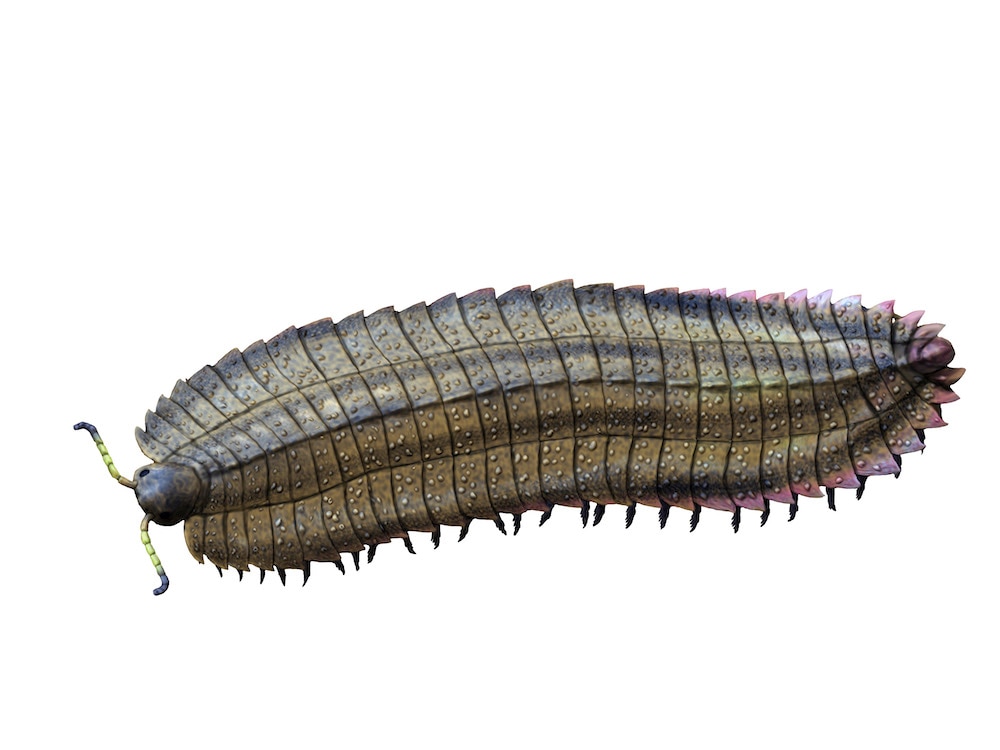Create a free profile to get unlimited access to exclusive videos, sweepstakes, and more!
Monster millipede the size of a car was the biggest bug ever
Millipedes in the genus Arthopleura were giant, but one of them was the hugest creepy crawler ever.

You know those special effects that involve filming insects up close and then superimposing them on a background to make them appear freakishly huge? This was not that.
They might have missed being horror movie stars by 300 million years, but millipedes in the genus Arthopleura were the most ginormous insects ever. Now the hugest fossilized exoskeleton of this creature has emerged (at least a segment of it). It is thought to have been literally the size of your average sedan at nearly eight feet long, and must have weighed about a hundred pounds. That easily makes this specimen the largest arthropod ever found — no special effects necessary.
Unearthed by researcher Neil Davies of Cambridge University, who led a study recently published in Journal of the Geological Society, this is a rare portal to the past. Insect exoskeletons rarely fossilize without crumbling. Creepy crawlies that are tiny enough are usually best preserved in globs of amber, but nothing like this. Turned out that a beam in Northumberland had fallen onto another and cracked it open, exposing this nightmare fuel.
"The best known fossils used to come from old coal mines, so people associated these with coal forests, but actually the tracks and this fossil suggest they lived in open woodland," Davies told SYFY WIRE.
Arthopleura used to thrive in what is now Northumberland because it was a lush, tropical hideaway during the Carboniferous period, when these many-legged monsters crept through the woods near the edges of rivers. The exoskeleton segment found had been molted off. That could mean this particular bug got even larger, though nobody will ever really know how many times it shed its outer shell during its lifetime. Most millipedes live about two years — but some are thought to make it to five and even ten. By then, this one might have reached minivan size. Davies agrees.
"It's likely this individual got bigger as it molted," he said.
How did this bug get to be such a behemoth? During the Carboniferous period, there was 10-15% more oxygen in the air. The larger the organism, the more oxygen it needs, and Arthropleura was taking massive amounts. Insects have no lungs, but “breathe” through tiny openings, or spiracles, all over their bodies, which explains high oxygen dependence. Spiracles are directly connected to tissues that need oxygen. So many prehistoric life-forms grew to unbelievable sizes hundreds of millions of years ago because there was more oxygen for them.
Obviously, Athropleura needed immense amounts of food, and while we can’t know what it ate for sure, extant millipedes are decomposers that go for fungi, rotting leaves, and other detritus. Maybe it chewed on a few small vertebrates or invertebrates along the way. The worst it would have ever done to modern humans is freak us out. To be able to survive alongside us, however, they would have had to somehow develop an adaptation to maximize oxygen intake from the atmosphere. The absence of birds and reptiles back then would have also helped. Insect sizes began to decrease when predatory birds appeared on the scene along with bug-craving reptiles during the late Jurassic and started snapping them up. There was also a lethal climate shift.
"Most likely, the assembly of the supercontinent Pangea led to increased aridity, meaning the previous forests were replaced by conifers," said Davies. "At the same time, reptiles rose to dominance; so effectively a double hit of less food and more competition."
What is mysterious about this new specimen is that it was preserved before atmospheric oxygen reached its peak, so species in this genus may really have grown to be SUVs with legs. The only other known Arthropleura fossils that have surfaced, both in Germany, were considerably smaller than this specimen. Whether they were a different species of Arthropleura, juveniles, or smaller individuals of the same species remains unknown. Maybe finding a fossilized head from at least one of these creepers would reveal more about them.
"We want to know more about its affinities, since it is directly related to modern millipedes, as well as have a better idea of what it was equipped to eat," Davies said.
Just don't let a car-size millipede creep into your dreams.


























